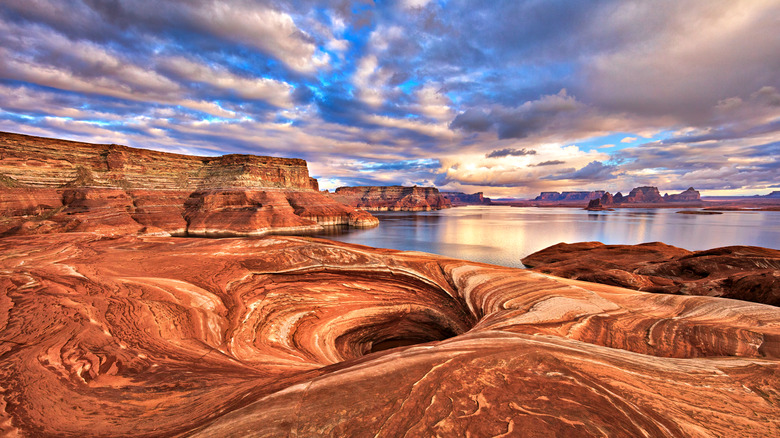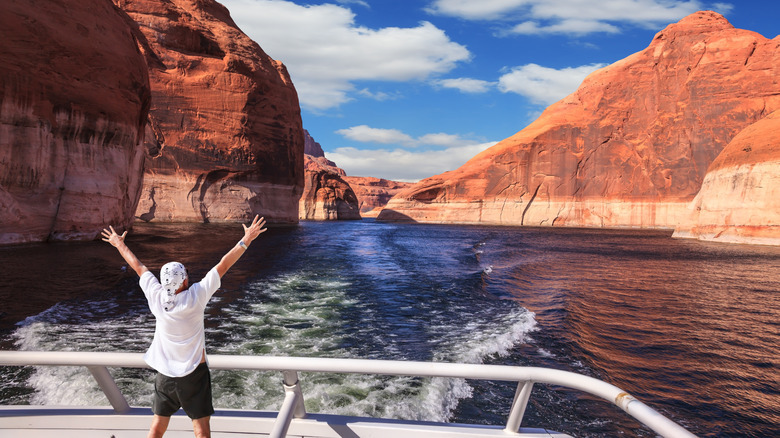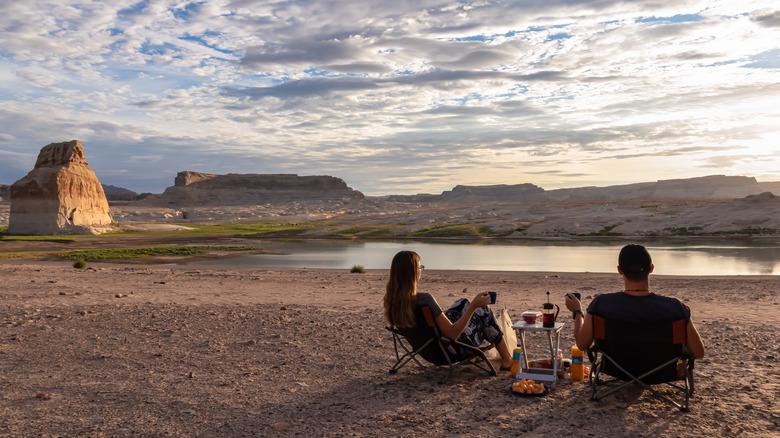Why This Popular National Recreation Area In The Western US Is So Dangerous
Glen Canyon National Recreation Area is a mesmerizing expanse of red-rock desert near Page, Arizona. Spanning over 1.25 million acres at the Arizona–Utah border, it incorporates some incredible natural wonders, including the scenic Orange Cliffs of southern Utah, the Rainbow Bridge (one of the largest naturally occurring rock bridges in the world), and Lake Powell, one of the largest human-made lakes in North America. The enormous reservoir constitutes 13% of the National Recreation Area, at 186 miles long with 1,960 miles of shoreline and more than 96 side canyons.
Each year, the lake and the other parts of Glen Canyon Recreation Area draw millions of visitors, who come to explore slickrock canyons and ancient Ancestral Puebloan ruins, and take part in a myriad of water sports on Lake Powell, from serene kayaking to more adrenaline-filled wakeboarding, waterskiing, and jet skiing. The lake is also considered one of the top stand-up paddleboard destinations in the world according to SUP Connect. Unfortunately, due to a combination of factors, many visitors have been lost, injured, or killed in Glen Canyon Recreation Area over the years. In fact, according to Forbes, Glen Canyon is one of the most hazardous recreation areas in the United States based on the number of search and rescues.
Overview of the area's dangers
The remoteness of Glen Canyon along with its rugged terrain and harsh desert conditions present extreme challenges for those unfamiliar with the area. Hikers risk falling on steep and exposed terrain, and those who wander off established trails can get lost in the desert. During the sweltering summer months, outdoor adventurers can experience dehydration and heat-related illnesses, whereas in the colder months, those without proper clothing are at risk for hypothermia. Flash floods can come on suddenly and often with little warning, particularly in slot canyons.
On Lake Powell, boating accidents are far too common, and sometimes result from a lack of boating experience or a failure to comply with safety regulations. Swimming is truly magical in Lake Powell — you're immersed in a huge body of water in the middle of the desert, with towering red cliffs on all sides. What? But there are no lifeguards present, and drownings can and do happen. Jumping from high bluffs is another hazardous activity at the lake that sometimes results in fatalities. In one incident reported by the National Park Service, a man leaped from a 50-foot cliff, hit the water, and did not resurface. He was later declared deceased.
Playing safely in Glen Canyon Recreation Area
Outdoor adventurers can prevent many accidents by adhering to the park's safety regulations. It may not be sexy, but adults should wear lifejackets when in a boat, and children should wear them basically anytime they're around water. Boaters should watch for rocks and other hazards to avoid dangerous collisions that can eject people from the boat. In addition, boaters should monitor the weather and steer toward protected coves whenever there's lightning. Cliff jumping is exhilarating, but the park forbids jumping off any bluff higher than 15 feet above the water.
Hikers have another important reason to monitor the weather — avoiding flash floods. In addition to checking the forecast, watch the sky and listen for thunder when hiking in canyons. At any sign of inclement weather, vacate narrow canyons immediately and head for higher ground. Stay on marked trails, inform someone of your plans, and carry sufficient water. In summer, stay off the trail during the warmest parts of the day, and if it's super hot, consider not hiking at all.
Much of the advice about staying safe boils down to common sense. When you're unwinding with your buddies in a dazzling location like this one, it's easy to lose your head and start taking stupid risks. Don't do it. There are so many ways to have a blast in Glen Canyon National Recreation Area without speeding your boat or belly-flopping off a cliff.


